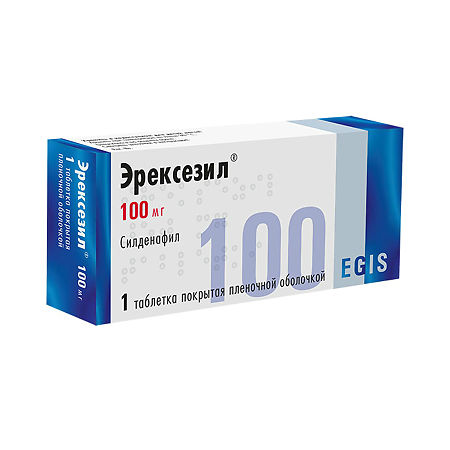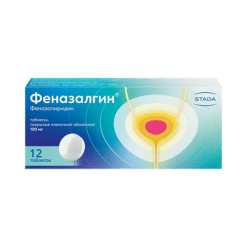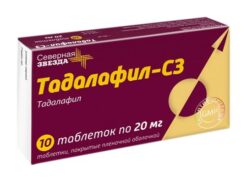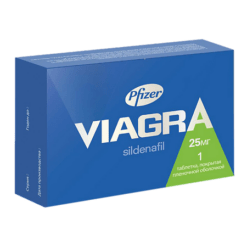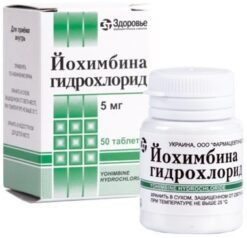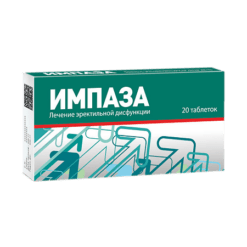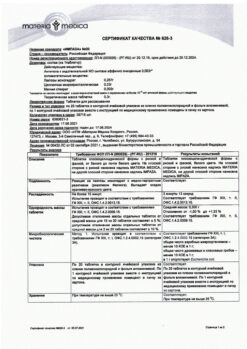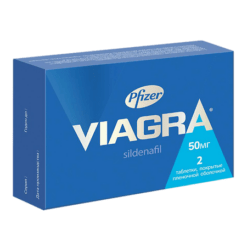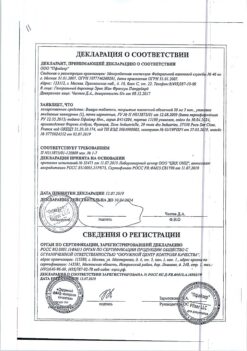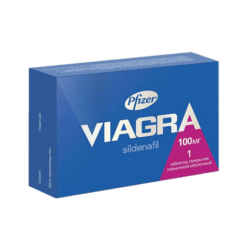No products in the cart.
Erexesil, 100 mg
€1.00
Out of stock
(E-mail when Stock is available)
Description
Erexesil is a remedy for the treatment of erectile dysfunction. It restores impaired erectile function and provides a natural response to sexual arousal.
Sildenafil is a potent and selective inhibitor of cGMP-specific phosphodiesterase type 5 (PDE5), which is responsible for the breakdown of cGMP in the corpora cavernosa. Sildenafil has no direct relaxing effect on the cavernous body, but it actively enhances the relaxing effect of nitric oxide on this tissue. During sexual excitement, local release of NO under the influence of sildenafil leads to inhibition of FDE5 and increase of cGMP level in the cavernous body, as a result of this there is relaxation of smooth muscles and increase of blood flow in the cavernous body.
Sildenafil can cause mild and transient color (blue/green) impairment. The inhibition of FDE6, which is involved in the transmission of light in the retina, is thought to be the presumed mechanism of color vision impairment. In vitro studies have shown that the effect of sildenafil on FDE6 is 10 times inferior to its activity against FDE5.
In vitro studies show that sildenafil’s activity against FDEP5 is 10-10000 times greater than its activity against other phosphodiesterase isoforms (FDEP 1, 2, 3, 4 and 6). In particular, sildenafil activity against FDE5 is 4,000 times greater than its activity against FDE3 – cAMP-specific phosphodiesterase involved in heart contraction.
Clinical data
Cardiac studies
The use of sildenafil in doses up to 100 mg did not result in clinically significant ECG changes in healthy volunteers. The maximum decrease in supine BP after sildenafil 100 mg was 8.3 mm Hg, and the maximum decrease in BP was 5.3 mm Hg. A more pronounced, but also transient effect on BP was observed in patients taking nitrates (see Contraindications and Interactions).
In a study of the hemodynamic effects of sildenafil in a single dose of 100 mg in 14 patients with severe CHD (more than 70% of patients had stenosis of at least one coronary artery), resting cAD and dAP decreased by 7 and 6%, respectively, and pulmonary systolic pressure decreased by 9%. Sildenafil did not affect cardiac output or impair blood flow in stenosed coronary arteries, and also resulted in an increase (by approximately 13%) in adenosine-induced coronary flow in both stenosed and intact coronary arteries.
In a double-blind, placebo-controlled study of 144 patients with erectile dysfunction and stable angina taking antianginal drugs (except nitrates), they exercised to the point where the severity of angina symptoms increased. Exercise duration was significantly longer (19.9 s; 0.9-38.9 s) in patients taking sildenafil in a single dose of 100 mg compared with patients receiving placebo.
The randomized, double-blind, placebo-controlled study examined the effect of a variable dose of sildenafil (up to 100 mg) in men (n=568) with erectile dysfunction and arterial hypertension who were taking more than two antihypertensive drugs. Sildenafil improved erections in 71% of men compared with 18% in the placebo group. The incidence of adverse effects was comparable to that in other patient groups, as well as in those taking more than three antihypertensive drugs.
Studies on visual impairment
In some patients, a mild and transient impairment in the ability to distinguish shades of color (blue/green) was detected 1 h after taking sildenafil at a dose of 100 mg using the Farnsworth-Munsel 100 test. These changes were absent 2 h after drug administration. The color vision impairment is thought to be caused by inhibition of FDE-6, which is involved in the transmission of light in the retina. Sildenafil had no effect on visual acuity, contrast perception, electroretinogram, IOP, or pupil diameter.
In a placebo-controlled, cross-over study of patients with proven early-onset macular degeneration (n=9), sildenafil at a single dose of 100 mg was well tolerated. There were no clinically significant changes in vision as assessed by specific visual tests (visual acuity, Amsler grid, color perception, color passage simulation, Humphrey perimeter, and photostress).
The efficacy and safety of sildenafil were evaluated in 21 randomized, double-blind, placebo-controlled trials, lasting up to 6 months, in 3000 patients aged 19 to 87 years with erectile dysfunction of various etiologies (organic, psychogenic or mixed). Efficacy of the drug was evaluated globally using an erection diary, the International Erectile Function Index (a validated sexual function questionnaire), and a partner survey.
The efficacy of sildenafil, defined as the ability to achieve and maintain an erection sufficient for satisfactory intercourse, has been demonstrated in all studies conducted and confirmed in long-term studies lasting 1 year. In fixed-dose studies, the proportion of patients reporting that therapy improved their erections was 62% (sildenafil 25 mg dose), 74% (sildenafil 50 mg dose), and 82% (sildenafil 100 mg dose) compared to 25% in the placebo group. Analysis of the International Index of Erectile Function showed that in addition to improved erection, sildenafil treatment also improved the quality of orgasm, allowed to achieve sexual satisfaction and overall satisfaction.
The data summarized that among patients who reported improved erections with sildenafil treatment were 59% of diabetic patients, 43% of patients who had undergone radical prostatectomy, and 83% of patients with spinal cord injuries (compared to 16%, 15%, and 12%, respectively, in the placebo group).
Pharmacokinetics
The pharmacokinetics of sildenafil in the recommended dose range are linear. After oral administration, sildenafil is rapidly absorbed from the gastrointestinal tract. Absolute bioavailability is 25-63%, on average 40%. In vitro sildenafil at a concentration of about 1.7 ng/ml (3.5 nmol) inhibits human FDE-5 activity by 50%. After a single sildenafil dose of 100 mg, the average Cmax of free sildenafil in the blood plasma of men is about 18 ng/ml (38 nmol). Cmax when sildenafil is taken orally on an empty stomach is reached on average within 60 min (30 to 120 min). When taken in combination with fatty food the absorption rate slows down, Cmax decreases on average by 29%, and Tmax increases by 60 min, but the degree of absorption does not change significantly (AUC decreases by 11%).
The Vss of sildenafil averages 105 L.
The binding to plasma proteins of sildenafil and its main circulating N-demethyl metabolite is about 96% and is independent of the total drug concentration. Less than 0.0002% of the sildenafil dose (188 ng on average) is detected in semen 90 minutes after taking the drug.
Sildenafil is metabolized primarily in the liver with the cytochrome P450 isoenzymes CYP3A4 (major pathway) and CYP2C9 (minor pathway). The main circulating active metabolite is formed as a result of N-demethylation of sildenafil and undergoes further metabolism. The metabolite is comparable with sildenafil in FDE selectivity, and activity of the metabolite against FDE-5 in vitro is about 50% of sildenafil activity. Plasma concentration of the metabolite in healthy volunteers is approximately 40% of that of sildenafil. The N-demethyl metabolite undergoes further metabolism, T1/2 is about 4 hours.
The total clearance of sildenafil is 41 l/h, and the final T1/2 is 3-5 h. After oral administration as well as after IV administration sildenafil is excreted as metabolites mainly by the intestine (about 80% of the oral dose) and to a lesser extent by the kidneys (about 13% of the oral dose).
Particular patient groups
Elderly patients. Healthy elderly patients (over 65 years of age) have reduced sildenafil clearance and plasma free sildenafil concentrations are about 40% higher than those of younger patients (18-45 years of age). Age has no clinically significant effect on the incidence of side effects.
Kidney function impairment. In mild (creatinine Cl 50-80 ml/min) and moderate (creatinine Cl 30-49 ml/min) renal impairment, the pharmacokinetics of sildenafil after a single oral dose of 50 mg does not change. In severe renal impairment (Cl creatinine AUC (100%) and Cmax (88%) compared to those in normal renal function in patients of the same age group.
Hepatic impairment. Sildenafil clearance is decreased in patients with cirrhosis (Child-Pugh stages A and B), resulting in increased AUC (84%) and Cmax (47%) compared to normal hepatic function in patients in the same age group. Pharmacokinetics of sildenafil in patients with severe hepatic impairment (Child-Pugh stage C) have not been studied.
In patients with cirrhosis (Child-Pugh grade A and B), sildenafil clearance is decreased, resulting in higher AUC (84%) and Cmax (47%) compared to those with normal liver function in patients in the same age group.
Indications
Indications
The treatment of erectile dysfunction characterized by the inability to achieve or maintain a penile erection sufficient for satisfactory intercourse.
Pulmonary hypertension.
Active ingredient
Active ingredient
Composition
Composition
1 film-coated tablet contains:
Active substance:
sildenafil citrate 140.48 mg (corresponding to sildenafil – 100 mg).
Associates:
Cellulose microcrystalline – 324.52 mg,
calcium hydrophosphate – 90 mg,
croscarmellose sodium – 36 mg,
magnesium stearate – 9 mg.
Shell contents:
Opadray II 85F20464 blue – 12 mg (polyvinyl alcohol – 4.8 mg, macrogol 3350 – 2.424 mg, titanium dioxide – 2.16 mg, talc – 1.776 mg, indigo carmine aluminum varnish – 0.84 mg).
How to take, the dosage
How to take, the dosage
Ingestion.
The recommended dose for most adult patients is 50 mg approximately 1 h before sexual activity. Depending on efficacy and tolerability, the dose may be increased to 100 mg or reduced to 25 mg. The maximum recommended dose is 100 mg. The maximum recommended frequency of use is once daily.
Kidney function abnormalities. No dose adjustment is required in mild to moderate renal impairment (creatinine Cl 30-80 ml/min), no dose adjustment is required in severe renal impairment (creatinine Cl
Hepatic impairment. Since sildenafil excretion is impaired in patients with liver damage (particularly in cirrhosis), the dose of sildenafil should be reduced to 25 mg.
Combined use with other drugs. When combined with ritonavir, the maximum single dose of sildenafil should not exceed 25 mg, and the frequency of use should be once every 48 hours (see “Interaction”). When co-administered with CYP3A4 isoenzyme inhibitors (erythromycin, saquinavir, ketoconazole, itraconazole), the initial dose of the drug should be 25 mg (see “Interaction”).
In order to minimize the risk of postural hypotension in patients taking α-adrenoblockers, Erexesil® should be started only after hemodynamic stabilization in these patients has been achieved. It should also be considered whether to reduce the initial dose of sildenafil (see “Interactions” and “Cautions”).
Elderly patients. No dose adjustment of Erexesil® is required.
Interaction
Interaction
Influence of other drugs on the pharmacokinetics of sildenafil
The metabolism of sildenafil occurs mainly under the action of cytochrome CYP3A4 isoenzymes (main pathway) and CYP2C9, therefore inhibitors of these isoenzymes may decrease sildenafil clearance, and inducers, respectively, increase sildenafil clearance. There was noted a decrease in sildenafil clearance when concomitant use of inhibitors of CYP3A4 cytochrome isoenzyme (ketoconazole, erythromycin, cimetidine). Cimetidine (800 mg), a non-specific inhibitor of cytochrome CYP3A4 isoenzyme, when taken together with sildenafil (50 mg) increases sildenafil concentration in plasma by 56%. A single use of sildenafil 100 mg together with erythromycin (500 mg / day 2 times a day for 5 days), a specific inhibitor of cytochrome CYP3A4, against the background of achieving Css of erythromycin in blood, increases sildenafil AUC by 182%. When taking sildenafil (100 mg once) and saquinavir (1200 mg / day 3 times a day), an HIV protease inhibitor and cytochrome CYP3A4 isoenzyme, against reaching Css of saquinavir in blood Cmax of sildenafil was increased by 140%, and AUC was increased by 210%. Sildenafil has no effect on the pharmacokinetics of saquinavir. Stronger inhibitors of cytochrome CYP3A4 isoenzyme, such as ketoconazole and itraconazole, may also cause greater changes in the pharmacokinetics of sildenafil.
The simultaneous use of sildenafil (100 mg once) and ritonavir (500 mg twice daily), an HIV protease inhibitor and strong cytochrome P450 inhibitor, on reaching the Css of ritonavir in blood leads to an increase in Cmax of sildenafil by 300% (4 times) and AUC by 1000% (11 times). After 24 h the plasma concentration of sildenafil is about 200 ng/ml (after a single use of sildenafil only 5 ng/ml).
If sildenafil is taken at the recommended doses in patients receiving concomitant strong CYP3A4 cytochrome isoenzyme inhibitors, the Cmax of free sildenafil does not exceed 200 nmol and the drug is well tolerated.
A single administration of an antacid (magnesium hydroxide/aluminum hydroxide) does not affect the bioavailability of sildenafil.
CYP2C9 isoenzyme inhibitors (tolbutamide, warfarin), CYP2D6 (SSRIs, tricyclic antidepressants), thiazide and thiazide-like diuretics, ACE inhibitors and calcium antagonists do not influence sildenafil pharmacokinetics.
Asithromycin (500 mg/day for 3 days) has no effect on the AUC, Cmax, Tmax, elimination rate constant and T1/2 of sildenafil or its major circulating metabolite.
The effect of sildenafil on other drugs
Sildenafil is a weak inhibitor of cytochrome P450 isoenzymes – 1A2, 2C9, 2C19, 2D6, 2E1 and 3A4 (IK50 >150 μmol). When sildenafil is taken at the recommended doses, its Cmax is about 1 μmol, so it is unlikely that sildenafil can affect the clearance of substrates of these isoenzymes.
Sildenafil enhances the hypotensive effect of nitrates both with long-term use of the latter and when prescribed for acute indications. Therefore, the use of sildenafil in combination with nitrates or nitric oxide donors is contraindicated.
The concomitant administration of the α-adrenoblocker doxazosin (4 or 8 mg) and sildenafil (25, 50, or 100 mg) in patients with benign prostatic hyperplasia with stable hemodynamics had a mean additional reduction in BPH and BPH in the supine position of 7/7, 9/5, and 8/4 mm Hg, respectively, and in the standing position. Hg, respectively, and in the standing position were 6/6, 11/4, and 4/5 mmHg, respectively. Rare cases of symptomatic postural hypotension, manifested as dizziness (without fainting), have been reported in these patients. In some sensitive patients receiving α-adrenoblockers, concomitant use of sildenafil may lead to symptomatic hypotension.
There are no signs of significant interaction with tolbutamide (250 mg) or warfarin (40 mg), which are metabolized by the cytochrome isoenzyme CYP2C9.
Sildenafil (100 mg) has no effect on the pharmacokinetics of HIV protease inhibitors, saquinavir and ritonavir, which are substrates of the cytochrome CYP3A4 isoenzyme, when their blood levels are constant.
Sildenafil (50 mg) does not cause an additional increase in bleeding time when taking acetylsalicylic acid (150 mg).
Sildenafil (50 mg) does not increase the hypotensive effects of alcohol in healthy volunteers with a blood alcohol Cmax of 0.08% (80 mg/dL) on average.
In patients with AH there is no evidence of interaction between sildenafil (100 mg) and amlodipine. The mean additional reduction of BP in the supine position is 8 mm Hg (cAH) and 7 mm Hg (dAH).
The use of sildenafil in combination with antihypertensive agents does not lead to additional side effects.
Special Instructions
Special Instructions
The diagnosis of erectile dysfunction, the determination of its possible causes, and the choice of appropriate treatment require a complete medical history and a thorough physical examination.
Sexual activity poses a definite risk in the presence of heart disease, so before starting any therapy for erectile dysfunction, the physician should refer the patient for a cardiovascular examination. Sexual activity is undesirable in patients with CH, unstable angina, MI or stroke in the past 6 months, life-threatening arrhythmias, AH (BP >170/100 mm Hg), or hypotension (BP mm Hg). Clinical studies have shown no difference in the rate of MI (1.1 per 100 patients/year) or CVD mortality (0.3 per 100 patients/year) in patients receiving sildenafil compared to patients receiving placebo.
The drugs intended to treat erectile dysfunction should not be prescribed for men for whom sexual activity is undesirable.
Sildenafil has a systemic vasodilator effect leading to a transient decrease in BP. This effect is not clinically significant and has no effect in most patients. Nevertheless, before prescribing the drug, the physician should carefully assess the risk of possible adverse vasodilator effects in patients with relevant diseases, especially against the background of sexual activity. Hypersensitivity to vasodilators is observed in patients with left ventricular outflow tract obstruction (aortic stenosis, hypertrophic obstructive cardiomyopathy) as well as with rare syndrome of multiple systemic atrophy manifested by severe disturbances of BP regulation by autonomic nervous system.
There have been rare cases of anterior ischemic optic neuropathy of nonarterial origin as a cause of visual impairment or loss with all FDE-5 inhibitors, including sildenafil. Most of these patients had risk factors such as optic nerve head excavation (deepening), age over 50 years, diabetes mellitus, AH, CHD, hyperlipidemia, and smoking. No causal relationship between the intake of FDE-5 inhibitors and the development of anterior ischemic optic neuropathy of nonarterial genesis has been identified. The physician should inform the patient of an increased risk of nonarterial anterior ischemic optic neuropathy if this condition has previously been reported.
Because co-administration of sildenafil and α-adrenoblockers may result in symptomatic hypotension in some sensitive patients, sildenafil should be prescribed with caution in patients taking α-adrenoblockers (see “Interactions”). To minimize the risk of postural hypotension in patients taking α-adrenoblockers, sildenafil should be started only after hemodynamic stabilization is achieved in these patients. It should also be considered whether it is reasonable to reduce the initial dose of the drug (see “Dosage and administration”). The physician should inform patients about what actions should be taken if symptoms of postural hypotension occur.
A small number of patients with hereditary retinitis pigmentosa have genetically determined retinal FDE dysfunction. There is no information about the safety of sildenafil use in patients with pigmentary retinitis, so sildenafil should be used with caution.
Sildenafil increases the anti-aggregation effect of sodium nitroprusside (NO donor) on human platelets in vitro. There is no information about the safety of sildenafil in patients with internal bleeding or active peptic ulcer, so it should be used with caution.
The treatment of erectile dysfunction should be used with caution in patients with anatomic deformities of the penis (angulation, cavernous fibrosis, Peyronie’s disease) or risk factors for priapism (sickle cell anemia, multiple myeloma, leukemia).
The safety and effectiveness of sildenafil combined with other drugs for the treatment of erectile dysfunction has not been studied, so the use of such combinations is not recommended (see “Contraindications”).
Some post-marketing and clinical studies using all FDE-5 inhibitors, including sildenafil, have reported a sudden reduction or loss of hearing in patients. However, most of these patients had risk factors for this pathology, and no correlation was found between the use of FDE-5 inhibitors and sudden hearing loss or reduction. In case of sudden hearing loss or decline, sildenafil therapy should be discontinued and a physician should be consulted immediately.
Impact on the ability to drive vehicles and operate machinery. No adverse effect on the ability to drive or operate machinery has been observed while taking sildenafil. However, since taking sildenafil may result in decreased blood pressure, chromatopsia, blurred vision, etc. side effects, care should be taken with the individual action of the drug in the above situations, especially at the beginning of treatment and when changing the dosing regimen.
Contraindications
Contraindications
With caution: anatomical malformation of the penis (angulation, cavernous fibrosis, Peyronie’s disease); diseases predisposing to priapism (myeloma disease, sickle cell anemia, leukemia, thrombocytopenia – see “Special Indications. The following conditions may also be associated with the development of apidism (myeloma, sickle cell disease, leukemia, thrombocytopenia – see “Special Precautions”); increased susceptibility to bleeding; exacerbation of gastric and duodenal ulcers; hereditary retinitis pigmentosa; heart failure (HF); unstable angina; myocardial infarction (MI) within the last 6 months; stroke or life-threatening arrhythmias; arterial hypertension (AH) (BP >170/110 mmHg/ Hg); hypotension. Hg) and hypotension (AD mm Hg) (see Special Precautions); episodes of anterior nonarteritic ischemic optic neuropathy in patients (history).
Side effects
Side effects
Sildenafil side effects are usually mild to moderate and transient.
In fixed-dose studies, the frequency of some adverse events has been shown to increase with increasing dose.
Abgans and organ systemsSide effectsSildenafil, %Placebo, %Frequent (>1/10)Nervous systemHeadache10.82.8Svasodilation (flushes to the facial skin)10.91.4Frequent (>1/100 and <1/10)Nervous systemDizziness2.91Organ of visionSight impairment (blurred vision, change in sensitivity to light)2.50.4Chromatopsia (mild and transient, mostly change in color perception)1.10.03SSSHysteric heartbeat10.2Rhythmic systemRinitis (nasal congestion)2.10.3GastrointestinalDyspepsia30.4/p>
When sildenafil was used in doses higher than recommended, adverse events were similar to those noted above, but tended to occur more frequently.
General disorders: hypersensitivity reactions (including skin rash).
CNS and peripheral nervous system disorders: seizures.
System disorders: tachycardia, decreased blood pressure, fainting, nasal bleeding.
Gastrointestinal disorders: vomiting.
Visual disorders: pain in the eyes, redness of the eyes/injections of the sclerae.
Reproductive system: prolonged erection and/or priapism.
Overdose
Overdose
Symptoms: an increase in the severity of side effects has been noted.
Treatment: symptomatic. Hemodialysis does not accelerate clearance of sildenafil, because the latter is actively bound to plasma proteins and is not excreted by the kidneys.
Similarities
Similarities
Additional information
| Shelf life | 4 years. |
|---|---|
| Conditions of storage | At a temperature not exceeding 25 °C. |
| Manufacturer | EGIS, Hungary |
| Medication form | pills |
| Brand | EGIS |
Related products
Buy Erexesil, 100 mg with delivery to USA, UK, Europe and over 120 other countries.

